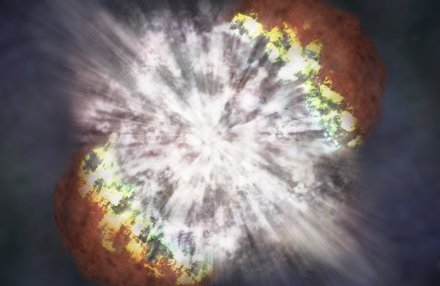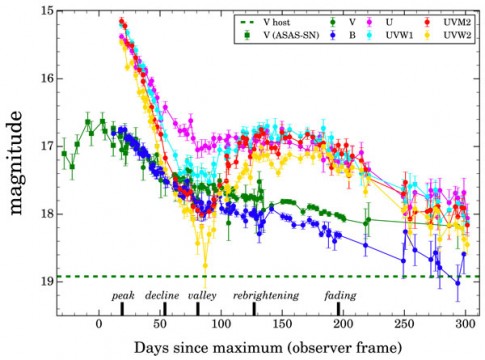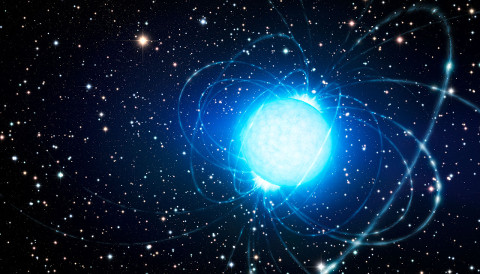In 2015 ASASSN-15lh gained fame as the most luminous supernova ever discovered. Almost a year later and against all odds, the supernova has rebrightened.
Remember the most luminous supernova ever? Well, it just got a little brighter.

NASA / CXC / M.Weiss
Subo Dong (Peking University, China) and colleagues discovered the powerful stellar explosion known as ASASSN-15lh on June 14, 2015, using the All-Sky Automated Survey for Supernovae (ASASSN). Four robotic 14-centimeter telescopes, collectively known as Cassius and stationed at Cerro Tololo, Chile, were staring at the entire visible sky when they spotted the flash. Since then, the supernova has baffled astronomers.
The typical supernova goes something like this: a star ages, burning up its core’s hydrogen, then helium, and so on up the element chain until it reaches iron, when fusion stops. At that point, the core can no longer support itself against the inward crush of gravity. The star’s outer layers rush inward too, but they bounce off the collapsed core and energy from the collapse throws them back out in a brilliant flash.
The light from ASASSN-15lh took almost 3 billion years to arrive at Earth, its extreme distance muting the visible brilliance to a mere 17th magnitude. Nevertheless, its peak power was more than twice that of any previously known stellar explosion. Usually, much of a supernova’s initial glow actually comes from radioactive nickel, created in abundance near the core. What’s weird about ASASSN-15lh (and a few others like it) is that they’re so bright, they’d need an awful lot of nickel to explain their glow.
Bright Again
Of course, ASASSN-15lh faded, as supernovae are wont to do. But this particular supernova held a surprise for researchers. Roughly three months after it began dimming, the supernova changed course. For 40-some days, its ultraviolet radiation charged up, increasing fivefold before plateauing for another couple of months and finally dropping away again. Radiation at visible wavelengths ignored this transformation and continued to fade unabated.

Godoy-Rivera et al., to appear in MNRAS
A born-again supernova isn’t unheard of. But typically when that happens, the blast has run into nearby gas that the star threw out before it exploded. ASASSN-15lh doesn’t display any of the emission lines you’d expect in its spectra if this were the case.
“Typically, a supernova interacting with its own ejecta should produce very strong emissions lines,” explains Krzysztof Stanek (Ohio State University), coauthor on the paper that will appear in the Monthly Notices of the Royal Astronomical Society. “We simply do not see any evidence for it. . . . I basically think that we can rule it out.”
But that means the reason for the resurgence remains, as coauthor Todd Thompson (Ohio State University) puts it, “difficult to explain.”
What is ASASSN-15lh?

ESO / L. Calçada
Until now, the most successful explanation of ASASSN-15lh’s oddities has been the magnetar. In this scenario, the core of an aging, massive star collapsed to form a spinning stellar remnant that’s like a neutron star but with a magnetic field at least 100 billion times the strength of the Sun’s strongest fields. Rather than radioactive elements, the supernova’s power would come from the magnetar’s gyrating magnetic field.
But as magnetars go, this one has to be pretty weird: to produce the radiation initially seen from ASASSN-15lh, the magnetar would have had to convert almost all its magnetic and rotational energy to radiation.
Now, factoring in the extra energy recently emitted in the ultraviolet makes the demands on the magnetar model even more stringent. “The magnetar model is safe, but barely,” says Thompson. “The magnetar [scenario] would be in danger if we saw roughly two times more energy. It would begin to push what we think is possible.
“Of course,” Thompson adds, “without another viable alternative, we might still try to make the magnetar model work.”
Not everybody agrees: Peter Brown (Texas A&M University) just posted another paper on the topic on the arXiv's astrophysics preprint server. Brown and colleagues argue that while the magnetar scenario might provide a good explanation of the initial ASASSN-15lh observations, it doesn't suffice to explain the object's resurgence at ultraviolet wavelengths.
Whatever ASASSN-15lh may be, one thing's for sure — the exceptional object isn't lending itself to any easy explanations.
 3
3









Comments
Noam Soker
May 14, 2016 at 12:51 am
The best alternative is a model that is based on powering by jets. Some of the pre-collapse core gas expands at low velocities in the equatorial plane. The gas falls back at later times. It is accreted on to the newly born neutron star, and later on to a black hole, through an accretion disk. The accretion disk launches jets that power the supernova for a long time. Such a model was developed recently by Avishai Gilkis and collaborators at the Technion, Israel .
You must be logged in to post a comment.
Lin4d
May 14, 2016 at 1:17 pm
Let’s take a quick look at the observational geometry for this supernova/supernovae: Here we are—the observers—and way over there are these possibly multiple, serial supernovae 3 billion light years away. Fusion physics demands that the supernova explosion quickly eviscerates the original, “mostly iron” elderly star’s massive nucleus, hurling its nuclear plasma in all directions while all of the subsequent energy-eating, endothermic fusion reactions synthesize nuclei more massive than iron (i. e., nickel to californium) in the expanding plasma. For obvious reasons, this is a very brief burst of gravitational and thermonuclear fusion power which can only happen only once for each old blue star. In fact, this “most luminous” supernova event exhibits characteristics which suggest it must have already involved multiple, closely packed old stars triggering the necessary implosions among themselves where gravitational contractions and "flash" thermonuclear fusion power the endothermic fusion reactions! We can’t optically resolve these compound supernovae. As seen by us at a distance of 3 billion light years (2.8·1025 meters), a dense star cluster having a radius of 0.15 light years would subtend an angle of ~ 10-10 radians which I can’t resolve even with my home-built 10.3 cm aperture refractor. Since 3 billion years (ago) is only a small fraction of the estimated age of “the Universe” as we define it, such a dense star cluster could easily be surrounded by a substantial collection of very close-by, gravitationally-unstable “elderly stars” whose iron cores might be blasted into “going supernova!” Although this is not exactly the same thing as accidently setting fire to a room packed full of “Roman Candles,” you get the idea. The incredibly long time duration observed for this/these “supernova/e explosion(s) already argue that this explanation is likely to be correct.
You must be logged in to post a comment.
Les
May 19, 2016 at 10:15 am
Interesting. Things explode, some explosions are dramatically larger than others. You know that Alan MacRobert on May 24 2008, notes that on 2008/03/19 there was a Gamma Ray Burst [GRB080319B] at about 7.5 billion light years distance detected by SWIFT that did not "resurge" or "re-brighten" but in total energy output was visible naked eye at around mag.+5.4 and recorded by the "Pi of the sky" group, in Poland with ordinary ccd's and a camara [pointed toward Bootes.]
PARAGRAPH
Monica, personally I get leery of "brightest," "largest," "farthest" labels for astronomical objects and events. The GRB080319B I note was assigned an AB Absolute Magnitude of -38.0, and Bloom et.al. "ruminate" that had the explosion been 10KPC [32,600 ly] distant instead of 7.5 billion light years distant it would have been optical [Visible light] magnitude -28.5 to the naked eye, if we discount the considerable line of sight optical extinction coefficient in the plane of the Milky Way that is an impressive amount of energy in an event . That is several times brighter than the Sun at a distance greater than the Sun's distance from Galactic Center . Bloom et. al. suggest local galactic frequencies for such outbursts at intervals of 100,000 to 1,000,000 years between events. To have the a superluminous jet's "beam" pointed our way reduces such incidences by factors that the authors calm the easily frightened to 10^10 to 10^11 years. Since we don't know much about such superluminous critters, the Milky Way may never have hosted one of these, and yet are we far enough away from Eta Carina to be safe when it goes off?
PARAGRAPH
See JS BLOOM ,et.al. 2008, in their " Observations of the Naked-Eye GRB 080319B: Implications of Nature’s
Brightest Explosion [published and still available at: http://arxiv.org/PS_cache/arxiv/pdf/0803/0803.3215v1.pdf%5D
This "Magnetar" super-supernova you report is indeed impressive, and we planet-living organisims, bright as we are, must be mindful that there are really scary and awesomely powerful events that even if millions or billions of light years distant can teach us about dangers that might lurk nearby. A superluminous beamed magnetar jet must certainly be one of those 'tools" galactic planners could use to clean up their populated neighborhoods. Scary stuff.
I think the models for magnetars needs more examples to get the data to refine them. I just hope the energetic examples can occur in someone else's backyard. You recall Fermi's Question, "Where are they?" These objects and events could wipe out lots of respectable neighbor hoods. These things can be hard on living things in what ever quarter of a galaxy they live.
You must be logged in to post a comment.
You must be logged in to post a comment.